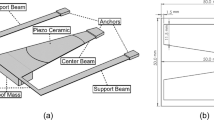Abstract
Vibrational energy scavenging using piezoelectric material is a viable method to provide sufficient energy for low-power wireless sensor networks. The applications for such devices in hospital settings as well as in vivo are abundant. Current devices are limited by both their design and material selection. This paper will address optimizing the design of microscale devices by showing how the device strains under input vibrations are directly proportional to its power output, and by proposing alternate designs which increase the strain distribution over more of the device volume. Finite element modeling (ANSYS®) was used to determine the strain distribution in a cantilever, modified cantilever, trapezoid, and spiral shaped piezoelectric microscale energy scavenging system. The increase in strain under uniform acceleration was determined to be 0, 29.2, 37.8, and 87.0%, respectively, over that of a simple cantilever.
Access this chapter
Tax calculation will be finalised at checkout
Purchases are for personal use only
Preview
Unable to display preview. Download preview PDF.
Similar content being viewed by others
References
Aziz, O., Lo, Benny P. L., King, R., Yang, Darzi, A., Guang-Zhong, (2006) “Pervasive Body Sensor Network: An Approach to Monitoring the Post-operative Surgical Patient,” Proceedings of the International Workshop on Wearable and Implantable Body Sensor Networks, Cambridge, MA, USA, April 3–5 2006, 13–16.
Glenn-Jones, P., Beeby, S., and White, N., (2001) “Towards a piezoelectric vibration-powered microgenerator, IEE Proc. Sci., Meas. Technol., vol. 148, 2001, 69–72.
Kymissis, J. et. al.,(1998) “Parasitic power harvesting is in shoes,” Proceedings of the Second IEEE International Conference on Wearable Computing ISWC, Pittsburg, PA, USA 1998.
Roundy, S., Otis, B., Chee, Y-H., Rabaey, J., and Wright, P.K., (2003) “A 1.9 GHz Transmit Beacon using Environmentally Scavenged Energy.” ISPLED, Seoul, Korea, August 25–27, 2003.
Mitcheson, P., Reilly, E., Wright, P., and Yeatman, E., (2006) “Transduction Mechanisms and Power Density for MEMS Inertial Energy Scavengers,” Proceeding of the Fourth International Conference on Power MEMS, Berkeley, CA, USA, 2006, in press.
Reilly, E., and Wright, P., (2006) “Thin Film Piezoelectric Energy Scavenging Systems for an On-Chip Power Supply” Proceeding of the Fourth International Conference on Power MEMS, Berkeley, CA, USA, 2006, in press.
Roundy, S., Wright, P. K., and Rabaey, J., (2003) “A Study of Low Level Vibrations as a Power Source for Wireless Sensor Nodes”, Computer Communications, vol. 26, no. 11, 1131–1144.
Reilly, E. (2004) “Design and Fabrication of a Thin Film Piezoelectric Vibrational Energy Scavenging System,” Masters Thesis, University of California Berkeley, Berkeley CA, 2004.
T. Bifano, H. Johnson, P. Bierden, and R. Mali, (2002) “Elimination of Stress-Induced Curvature in Thin-Film Structures,” J. Microelectromech. Sys., 11,5, (2002) 592–597.
Author information
Authors and Affiliations
Corresponding author
Editor information
Editors and Affiliations
Rights and permissions
Copyright information
© 2007 International Federation for Medical and Biological Engineering
About this paper
Cite this paper
Reilly, E.K., Miller, L.M., Wright, P.K. (2007). Optimizing On-Chip Piezoelectric Energy Scavenging for Integration of Medical Sensors with Low-Power Wireless Networks. In: Leonhardt, S., Falck, T., Mähönen, P. (eds) 4th International Workshop on Wearable and Implantable Body Sensor Networks (BSN 2007). IFMBE Proceedings, vol 13. Springer, Berlin, Heidelberg. https://doi.org/10.1007/978-3-540-70994-7_19
Download citation
DOI: https://doi.org/10.1007/978-3-540-70994-7_19
Publisher Name: Springer, Berlin, Heidelberg
Print ISBN: 978-3-540-70993-0
Online ISBN: 978-3-540-70994-7
eBook Packages: EngineeringEngineering (R0)




